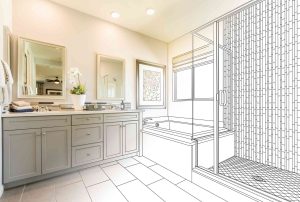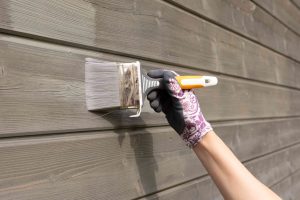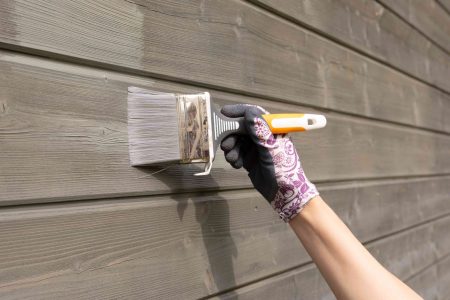For cutting down trees and pruning large branches, a chainsaw is incomparable. If you have ever cut trees by hand, you will be surprised at a chainsaw’s ease and speed. Small trees can be felled and branches removed in mere minutes.
Chainsaws are valuable for cutting large items because of their long guide bars. Electric chainsaw guide bars are available in lengths up to 18 inches. Gas chainsaws range even longer—up to 48 inches. As long as you adhere to your chainsaw’s safety precautions, there is no reason using a chainsaw should be anything but safe, even if you have never used one before.
What Is a Chainsaw?
A chainsaw is a portable gas-powered or electrically powered tool for cutting large pieces of rough wood, such as trees and logs. A sharpened metal chain wraps around the saw’s guide bar and rotates clockwise (as viewed from the user’s right side).
Typical Projects With a Chainsaw
Chainsaws are intended only for cutting wood, in projects such as:
- Felling trees within the chainsaw’s operating diameter
- Cutting (or bucking) fallen trees into smaller sections, either for firewood or disposal
- Pruning large branches from trees
- Cutting pruned branches into small sections for composting or disposal
- Pollarding trees
Chainsaw vs. Reciprocating Saw
A chainsaw is meant for outdoor use on trees and limbs. A reciprocating saw is mostly used for cutting lumber for construction projects. Even so, many gardeners and do-it-yourselfers use reciprocating saws along with chainsaws for outdoor jobs.
| Chainsaw | Reciprocating Saw | ||
| Cut Size | 14 to 48 inches | 2 to 6 inches | |
| Power Source | Gas or electric | Electric | |
| Cut Type | Rough cuts | Finer cuts | |
| Cuts on Ground | No, work material must always be elevated | Yes, cuts limbs on the ground or roots embedded in soft ground | |
| Blade Replacement | Difficult, requires threading the chain through the saw | Easy to do, either with a push-fit collar system or a wrench | |
| Best For | Standing trees, large limbs, or felled logs that are properly supported | Small limbs (1 to 3 inches) or tree roots |
Key Parts of a Chainsaw
- Guide Bar: The long steel bar at the front of the chainsaw. The chain wraps around the guide bar.
- Nose: The front, rounded portion of the guide bar.
- Bumper Spikes: Metal spikes on the front of the chainsaw housing that point toward the chainsaw’s nose. Bumper spikes hold the chainsaw solidly in place against the wood as the saw cuts.
- Chain: Drive links on the inside of the chain slide through a groove on the guide bar, driven by a sprocket in the engine housing.
- Chain Brake: A plastic or metal bar that acts as a safety device, shutting off the saw in the event of kickback. The chain brake moves forward and backward.
- Front Handle: Located on the front-top of the chainsaw, the front handle allows the user to hold most of the saw’s weight with their free hand.
- Back Handle: Usually molded into the chainsaw’s housing, the back handle lets the user balance out the rest of the saw’s weight. The back handle also has the throttle and the throttle lock.
- Throttle: Located on the back handle, the throttle is the trigger that controls the power and speed of the chainsaw.
- Throttle Lock: Located on the opposite side of the throttle, the throttle lock is a safety mechanism that must be engaged for the throttle to work.
- Pull Starter: A feature only of gas chainsaws, the pull starter is the handled cord that starts up the gas engine.
Incorrect vs. Correct Uses for a Chainsaw
| Incorrect/Inappropriate | Correct/Appropriate |
| Cutting non-wood material such as plastic, masonry, or metal | Use a miter saw, oscillating multi-tool, or rotary saw for these materials instead |
| Cutting dimensional lumber such as four-by-fours | Use a circular saw or reciprocating saw instead |
| Splitting logs | Use a log splitter |
| Cutting on the ground | Elevate the material |
| Pinch chainsaw bar in the cut | Add pressure below the material to widen the groove |
| Cut with top of the chainsaw guide bar | Cut with the bottom of the saw guide bar |
| Plunge cut with the nose of the saw | Cut only on the bottom of the saw bar |
Where to Use a Chainsaw
Limit the operation of the chainsaw to outdoor areas. Gasoline-powered devices, including chainsaws, should never be used in enclosed areas due to the risk of carbon monoxide poisoning. Electric-powered chainsaws do not emit carbon monoxide.
Chainsaw Safety Tips
Chainsaws can be operated efficiently and safely. Be sure to carefully read your chainsaw’s operator’s manual, as all chainsaws are different. The operator’s manual is your complete guide to the safe operation of your chainsaw.
Understand All Parts of the Chainsaw
Learn about each part of the chainsaw and its function before powering up the saw. For example, it can be easy to confuse the chain brake and the handle, as they look alike and are located in approximately the same position.
Tension the Chain Properly
Before turning on, plugging in, or otherwise activating the chainsaw, make sure that the chain is properly tensioned on the guide bar. A loose chain may whip free or draw materials into it. A tight chain may not move at all.
Prevent Kickback
Chainsaw kickback happens when the upper quadrant of the nose of the chainsaw guide bar touches an object when the chain is moving. Another cause of kickback is when the wood or any other object closes in and pinches the moving chain. Chainsaws with smaller guide bars have a reduced (but not eliminated) chance of kickback.
Never cut a tree or branch with a diameter wider than the length of the chainsaw’s guide bar. A guide bar is the solid metal section that protrudes from the front of the chainsaw and over which the chain slides. Avoid touching the front end of the saw to any surface during operation.
Limit Proximity to Saw Chain
Chainsaws not only can cut you, but you might become entangled in their rapidly moving chains. Clothing, hair, jewelry, gloves, and anything loose might get caught between the chain and the guide bar, drawing you toward the saw or the saw toward you.
Protect Hearing and Eyes
With chainsaws, hearing and eye protection are both required. An average gasoline-powered chainsaw produces a noise of about 120 dBs—just under the sound of a military jet lifting off. Debris blowback, too, is the norm with chainsaw operations, making eye protection mandatory.
Avoid Touching the Chain, Even When Stationary
Chainsaws’ chains are very sharp. Even when the chain is not moving, it can severely lacerate the skin. Be sure to keep the cover on the saw when not in use.
How to Use a Chainsaw
-
Prepare the Saw
Inspect the chainsaw and make sure that it is topped with oil (even electric chainsaws require oil). Tension the chain: there should be no slack on the underside of the chain. If the chain is dull, replace it. If the saw is gasoline-powered, make sure that it is full of fuel. If it is electrical, have the fuel cell fully charged or have an extension cord nearby.
-
Position the Work Material
Always have the work material positioned before powering up the chainsaw. If felling a tree, determine the cut point. If bucking, position the wood so that the cut end will drop free of the main section.
-
Unlock the Saw
Most chainsaws have some type of locking device for safety. Disengage this lock-out device.
-
Power the Saw
With hearing and eye protection in place, turn on the saw. Let the saw run for a few seconds while observing the chain tension. Sometimes, a chain that appeared to be properly tensioned with stationary may loosen when moving.
-
Make the Cut
Rest the bottom of the guide bar on top of the work material. Due to the motion of the chain, the saw will begin to tug away from you. You should gently pull back on the saw to counteract this motion. As much as possible, rely on the weight of the chainsaw itself, rather than manual force, to press the saw into the wood.
Chainsaw Maintenance Tips
- Use proper oil suited for chainsaws. Do not use motor oil.
- Never store the chainsaw wet. Always dry off the chainsaw after use.
- Empty gasoline from the chainsaw before long periods when it won’t be used.
- Keep the chain properly tensioned.
- Make sure that the air filter on gas models is clean. Change as needed.
When to Replace the Chain
If you believe that the chain may be dull or damaged, remove the chain from the saw and examine it closely. Any of these conditions may mean that the chain needs to be replaced:
- All cutting links should move freely yet should still be tightly attached. They should not be rusted.
- The chain should not move from side to side. If it wobbles from side to side, this indicates loose links.
- The bottom of the links should still have a curved shape to properly interlock with the saw’s sprocket. If the curved shape has worn away, the sprocket cannot safely move the chain.
When to Sharpen the Chain
The leading edges of the chain’s teeth should be angled and sharp. You should feel an edge similar to a dull paring knife when you run your fingers along the chain. If the blade is dull, it can be manually sharpened with a metal file and a Speed Square.
For more accurate sharpening, or for frequent sharpening, purchase an electric sharpener. Available for $50 to $100, electric sharpeners have built-in angle guides.
Should You Buy or Rent a Chainsaw?
-
You have wooded acreage
-
You expect to use it more than twice a year
-
You need it for cutting light trees or limbs, so a less expensive electric model fits your needs
-
You expect to use it just once or twice a year
-
You’re not interested in maintaining the tool throughout the year
-
You have large trees or limbs that require a large, expensive chainsaw
Read the full article here














